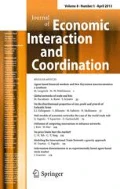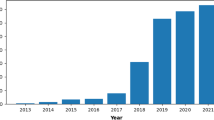Abstract
This paper builds an agent-based model to reproduce the results of an experimental stock market that studies how the market aggregates private information. The aim is to use experiments and agent-based modeling to analyze the trading behavior in experimental stock markets. Using the experimental environment and results, it is possible to formulate a hypothesis about the subjects’ behavior and thereby formalize (algorithmically) the trading behavior in an agent-based model. This may lead to a better understanding of how the market converges to an equilibrium and of the mechanism that allows dissemination of private information in the market.
















Similar content being viewed by others
Notes
A detailed description of the algorithms can be found in Cliff and Bruten (1997). The (Python) code is available on request.
In some experimental sessions the traders could trade more than one asset, but always a given number of assets. This procedure is useful as it simplifies the traders’ decision making and provides a definition of the demand and supply schedule.
\(R_i\) is distributed as a uniform random variable \(U(1,1.05)\) and \(e_i\) is distributed as a uniform random variable U(0,0.05).
\(R_i\) is distributed as a uniform random variable \(U(0.95,1)\) and \(e_i\) is distributed as a uniform random variable U(\(-\)0.05,0).
The value of the parameters are the following: initial value for \(\mu \sim U(0.30,0.45)\) for sellers and \(\mu \sim U(-0.45,-0.30)\) for buyers; \(\beta \sim U(0.1,0.5),\,\gamma \sim U(0.2,0.8)\). During each simulated period each agent will issue an order—if she is active—on average every 20 (simulated) seconds. Each trader has therefore the same given probability to issue an order in each time step. One period lasts 500 s.
Also the Augmented Dickey Fuller test rejects the null-hypothesis of non-stationarity of the price time series.
The author thanks Barner, Feri and Plott for providing the experimental data.
Francs are the experimental currency which will be converted into $ at a fixed rate (1,000 francs = 1$) at the end of the experiment.
The market consists of 22 traders. The code is available on request.
Resulting \(\alpha \) from the first to the fifth minute: 14.6, 18.1, 12.8, 1,414,213,552.47, 1,055,280.66.
All orders below 200 and above 1,000. Of 1,221 orders, only 74 are eliminated. For example there is a sell order of 100 billion francs (this is probably an error) and many buy orders of almost 0.
Period 1: 32.14; period 2: 20.77; period 3: 9.63.
The traders’ private value is distributed as a Normal with expected value equal to the theoretical expected value and variance equal to 5. Note that the variance cannot be computed from the data since the private values are not observable. Different values of the variance influences the volatility of the price around the equilibrium price. The code is available on request.
The code is available on request.
Barner et al. (2005) call it ITRRH: Informed Traders Rat Race Hypothesis.
Note that Fig. 11 shows the only wrong non-compatible order placed by an informed trader in the first minute of a bubble. It comes after two transactions in the wrong direction and just before a non-informed trader accepts an (informed) sell proposal at a price of 575, which actually triggers the bubble.
The condition resulting from the definition of the behavioral hypothesis on the learning mechanism are \(\omega ^{up} > \omega ^{down},\,\omega ^{up}<1\) and \(\omega ^{down}>0\). Given these conditions, different values of the parameters have very little effect on the learning mechanism.
Non-compatibility has a subjective definition since it derives from the comparison between the private value and the price of the order.
In both simulations the learning parameters are \(\omega ^{up} = 0.4\) and \(\omega ^{down}=0.1\). The code is available on request.
References
Anufriev M, Hommes C (2012) Evolutionary selection of individual expectations and aggregate outcomes in asset pricing experiments. Am Econ J Microecon 4(4):35–64
Anufriev M, Arifovic J, Ledyard J, Panchenko V (2011) Efficiency of continuous double auctions under individual evolutionary learning with full or limited information. J Evol Econ 1–35. doi:10.1007/s00191-011-0230-8
Axtell R (2000) Why agents? On the varied motivations for agent computing in the social sciences. Center on Social and Economic Dynamics Working Paper (17)
Barner M, Feri F, Plott CR (2005) On the microstructure of price determination and information aggregation with sequential and asymmetric information arrival in an experimental asset market. Ann Financ 1:73–107
Boero R, Bravo G, Castellani M, Squazzoni F (2010a) Why bother with what others tell you? An experimental data-driven agent-based model. J Artif Soc Soc Simul 13(3). http://jasss.soc.surrey.ac.uk/13/3/6.html
Bravo G, Boero R, Squazzoni F (2012) Trust and partner selection in social networks: an experimentally grounded model. Soc Netw 34(4):481–492
Camerer C, Weigelt K (1991) Information mirages in experimental asset markets. J Bus 64(4):463–493
Chan NT, LeBaron B, Lo AW, Poggio T (2001) Agent-based models of financial markets: a comparison with experimental markets. MIT Sloan Working Paper (4195–01)
Cliff D, Bruten J (1997) Minimal-intelligence agents for bargaining behaviors in market based environments. HP Laboratories Bristol (HPL-97-91)
Contini B, Leombruni R, Richiardi M (2007) Exploring a new expace the complementarities between experimental economics and agent-based computational economics. J Soc Complex 3(1):13–22
Copeland TE, Friedman D (1986) The effects of sequential information arrival on asset prices: an experimental study. J Financ 42(3):763–797
Copeland TE, Friedman D (1991) Partial revelation of information in experimental asset markets. J Financ 46(1):265–295
Duffy J (2006) Agent-based models and human subject experiments. In: Handbook of computational economics, vol 2. Elsevier, Amsterdam, pp 949–1011
Duffy J, Ünver MU (2006) Asset price bubbles and crashes with near-zero-intelligence traders. Econ Theory 27:537–563
Epstein JM, Axtell R (1996) Growing artificial societies: social science from the bottom up. The MIT Press, Cambridge
Fano S, LiCalzi M, Pellizzari P (2011) Convergence of outcomes and evolution of strategic behavior in double auctions. J Evol Econ. doi:10.1007/s00191-011-0226-4
Forsythe R, Lundholm R (1990) Information aggregation in an experimental market. Econometrica 58(2):309–347
Gjerstad S, Dickhaut J (1998) Price formation in double auctions. Games Econ Behav 22(1):1–29
Gjerstad S, Sachat JM (2007) Individual rationality and market efficiency. Institute for Research in the Behavioral, Economic and, Management Science (1204)
Gneezy U (1996) Probability judgments in multi-stage problems: experimental evidence of systematic biases. Acta Psychol 93:59–68
Gode DK, Sunder S (1993) Allocative efficiency of markets with zero-intelligence traders: market as a partial substitute for individual rationality. J Polit Econ 101(1):119–137
Grazzini J (2012) Analysis of the emergent properties: stationarity and ergodicity. J Artif Soc Soc Simul 15(2)
Holden CW, Subrahmanyam A (1992) Long-lived private information and imperfect competition. J Financ 47(1):247–270
Hommes C (2011) The heterogeneous expectations hypothesis: some evidence from the lab. J Econ Dyn Control 35:1–24
Hommes C, Sonnemans J, Tunistra J, van de Velde H (2005) Coordination of expectations in asset pricing experiments. Rev Financ Stud 18(3):955–980
King RR, Smith VL, Williams A, van Boening M (2001) The robustness of bubbles and crashes in experimental stock markets. Econometrica 69(4):831–859
Kyle AS (1985) Continuous auction and insider trading. Econometrica 53(6):1315–1335
Lei V, Noussair CN, Plott CR (2001) Nonspeculative bubbles in experimental asset markets: lack of common knowledge of rationality vs actual irrationality. Econometrica 69(4):831–859
Mitchell TM (1997) Machine learning. McGraw-Hill, New York
Noussair C, Robin S, Ruffleux B (2001) Price bubbles in laboratory asset markets with constant fundamental values. Exp Econ 4:87–105
Plott CR (2000) Market as information gathering tools. South Econ J 67(1):1–15
Plott CR, Sunder S (1982) Efficiency of experimental security markets with insider information: an application of rational-expectations models. J Polit Econ 90(4):663–698
Plott CR, Sunder S (1988) Rational expectations and the aggregation of diverse information in laboratory security markets. Econometrica 56(5):1085–1118
Smith VL (1962) An experimental study of competitive market behavior. J Polit Econ 70(2):111–137
Smith VL (1982) Microeconomic systems as an experimental science. Am Econ Rev 72:923–955
Smith VL, Suchanek GL, Williams AW (1988) Bubbles, crashes, and endogenous expectations in experimental spot asset markets. Econometrica 56(5):1119–1151
Smith VL, van Boening M, Wellford CP (2000) Dividend timing and behavior in laboratory asset markets. Econ Theory 16(3):567–583
Tversky A, Kahneman D (1974) Judgment under uncertainty: heuristics and biases. Science 185(4157): 1124–1131
Zhang T, Brorsen BW (2011) Oligopoly firms with quantity-price strategic decisions. J Econ Inter Coord 6:157–170
Author information
Authors and Affiliations
Corresponding author
Additional information
The research leading to these results has received funding from the European Union, Seventh Framework Programme FP7/2007-2013 under grant agreement n CRISIS-ICT-2011-288501. The author wishes to thank the two anonymous referees for their stimulating comments.
Rights and permissions
About this article
Cite this article
Grazzini, J. Information dissemination in an experimentally based agent-based stock market. J Econ Interact Coord 8, 179–209 (2013). https://doi.org/10.1007/s11403-013-0109-x
Received:
Accepted:
Published:
Issue Date:
DOI: https://doi.org/10.1007/s11403-013-0109-x




